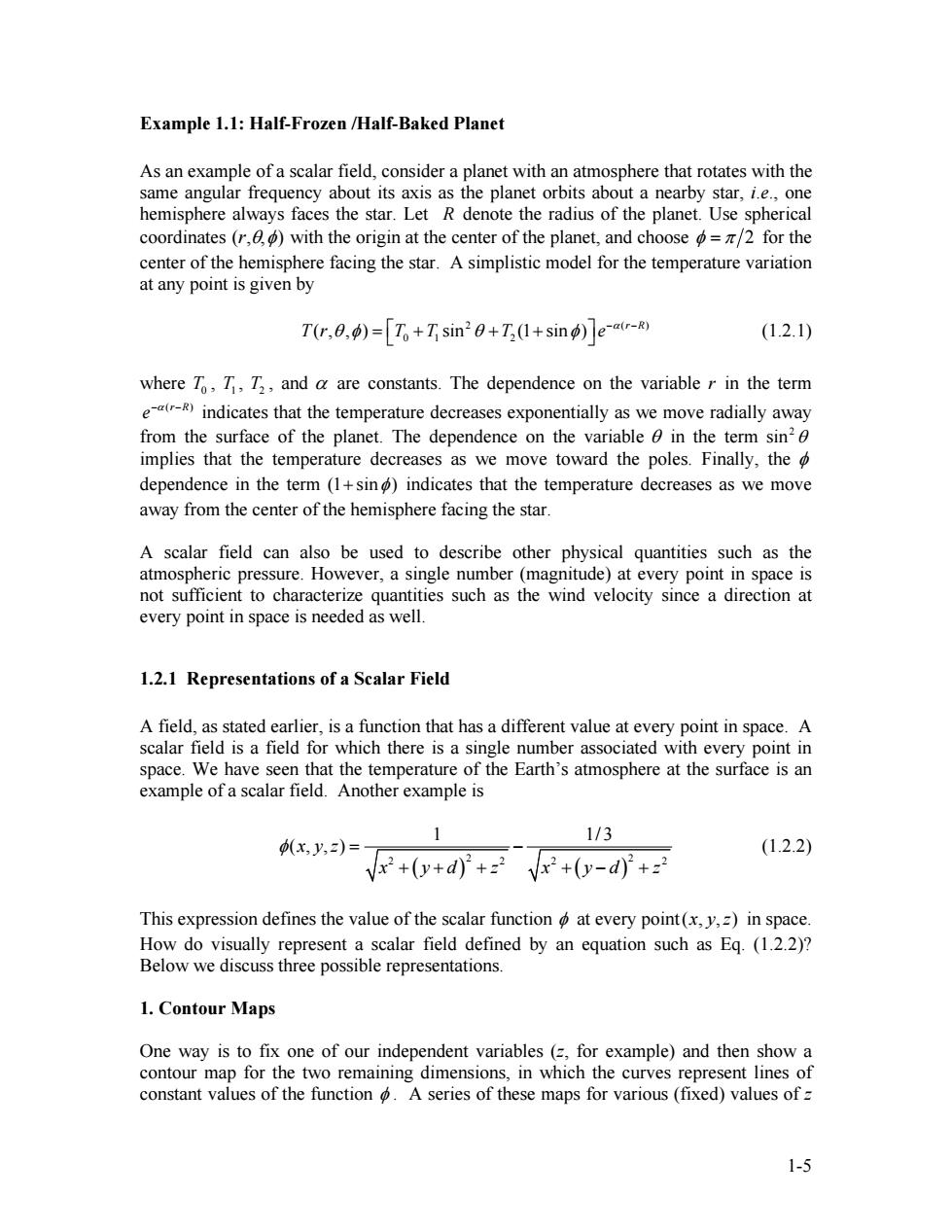正在加载图片...

Example 1.1:Half-Frozen /Half-Baked Planet As an example of a scalar field,consider a planet with an atmosphere that rotates with the same angular frequency about its axis as the planet orbits about a nearby star,i.e.,one hemisphere always faces the star.Let R denote the radius of the planet.Use spherical coordinates (r,e)with the origin at the center of the planet,and choose =z/2 for the center of the hemisphere facing the star.A simplistic model for the temperature variation at any point is given by T(r,0,)=[T+Tsin0+(+sin)e-(-R) (1.2.1) where To,T,T2,and a are constants.The dependence on the variable r in the term eindicates that the temperature decreases exponentially as we move radially away from the surface of the planet.The dependence on the variable in the term sin2 implies that the temperature decreases as we move toward the poles.Finally,the dependence in the term(1+sin)indicates that the temperature decreases as we move away from the center of the hemisphere facing the star. A scalar field can also be used to describe other physical quantities such as the atmospheric pressure.However,a single number(magnitude)at every point in space is not sufficient to characterize quantities such as the wind velocity since a direction at every point in space is needed as well. 1.2.1 Representations of a Scalar Field A field,as stated earlier,is a function that has a different value at every point in space.A scalar field is a field for which there is a single number associated with every point in space.We have seen that the temperature of the Earth's atmosphere at the surface is an example of a scalar field.Another example is 1 1/3 (x,y,z)= (1.2.2) Vx+(y+d)2+2 Vx2+(y-d02+z2 This expression defines the value of the scalar function at every point(x,y,z)in space. How do visually represent a scalar field defined by an equation such as Eq.(1.2.2)? Below we discuss three possible representations. 1.Contour Maps One way is to fix one of our independent variables (for example)and then show a contour map for the two remaining dimensions,in which the curves represent lines of constant values of the function A series of these maps for various (fixed)values ofz 1-51-5 Example 1.1: Half-Frozen /Half-Baked Planet As an example of a scalar field, consider a planet with an atmosphere that rotates with the same angular frequency about its axis as the planet orbits about a nearby star, i.e., one hemisphere always faces the star. Let R denote the radius of the planet. Use spherical coordinates (r,θ,φ) with the origin at the center of the planet, and choose φ = π 2 for the center of the hemisphere facing the star. A simplistic model for the temperature variation at any point is given by 2 () 01 2 ( , , ) sin (1 sin ) r R Tr T T T e α θφ θ φ − − =+ + + ⎡ ⎤ ⎣ ⎦ (1.2.1) where T0 , T1 , T2 , and α are constants. The dependence on the variable r in the term ( ) r R e− − α indicates that the temperature decreases exponentially as we move radially away from the surface of the planet. The dependence on the variable θ in the term 2 sin θ implies that the temperature decreases as we move toward the poles. Finally, the φ dependence in the term (1 sin ) + φ indicates that the temperature decreases as we move away from the center of the hemisphere facing the star. A scalar field can also be used to describe other physical quantities such as the atmospheric pressure. However, a single number (magnitude) at every point in space is not sufficient to characterize quantities such as the wind velocity since a direction at every point in space is needed as well. 1.2.1 Representations of a Scalar Field A field, as stated earlier, is a function that has a different value at every point in space. A scalar field is a field for which there is a single number associated with every point in space. We have seen that the temperature of the Earth’s atmosphere at the surface is an example of a scalar field. Another example is ( ) ( ) 2 2 2 22 2 1 1/3 (, ,) xyz x yd z x yd z φ = − + + + +− + (1.2.2) This expression defines the value of the scalar function φ at every point(, ,) x y z in space. How do visually represent a scalar field defined by an equation such as Eq. (1.2.2)? Below we discuss three possible representations. 1. Contour Maps One way is to fix one of our independent variables (z, for example) and then show a contour map for the two remaining dimensions, in which the curves represent lines of constant values of the function φ . A series of these maps for various (fixed) values of z